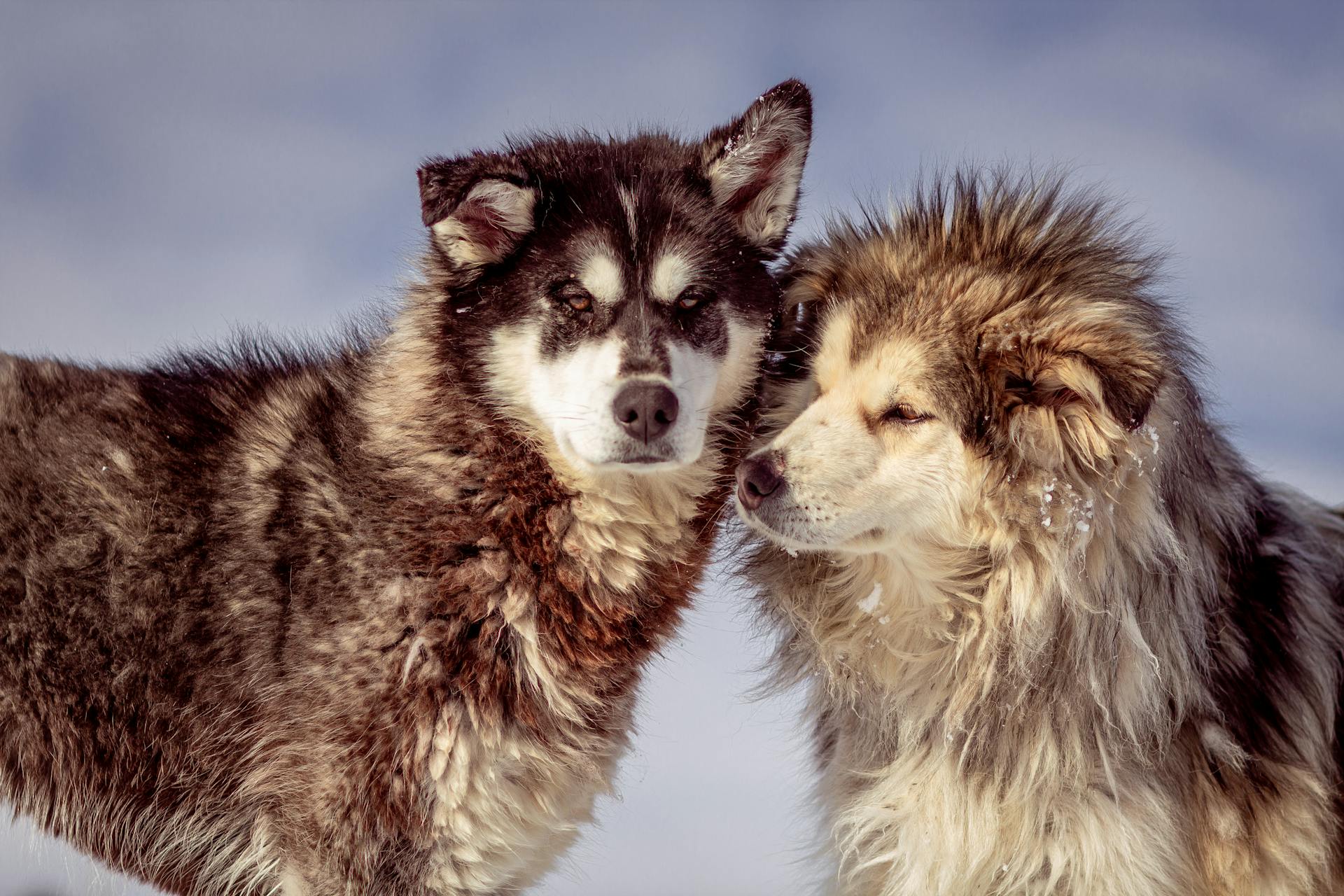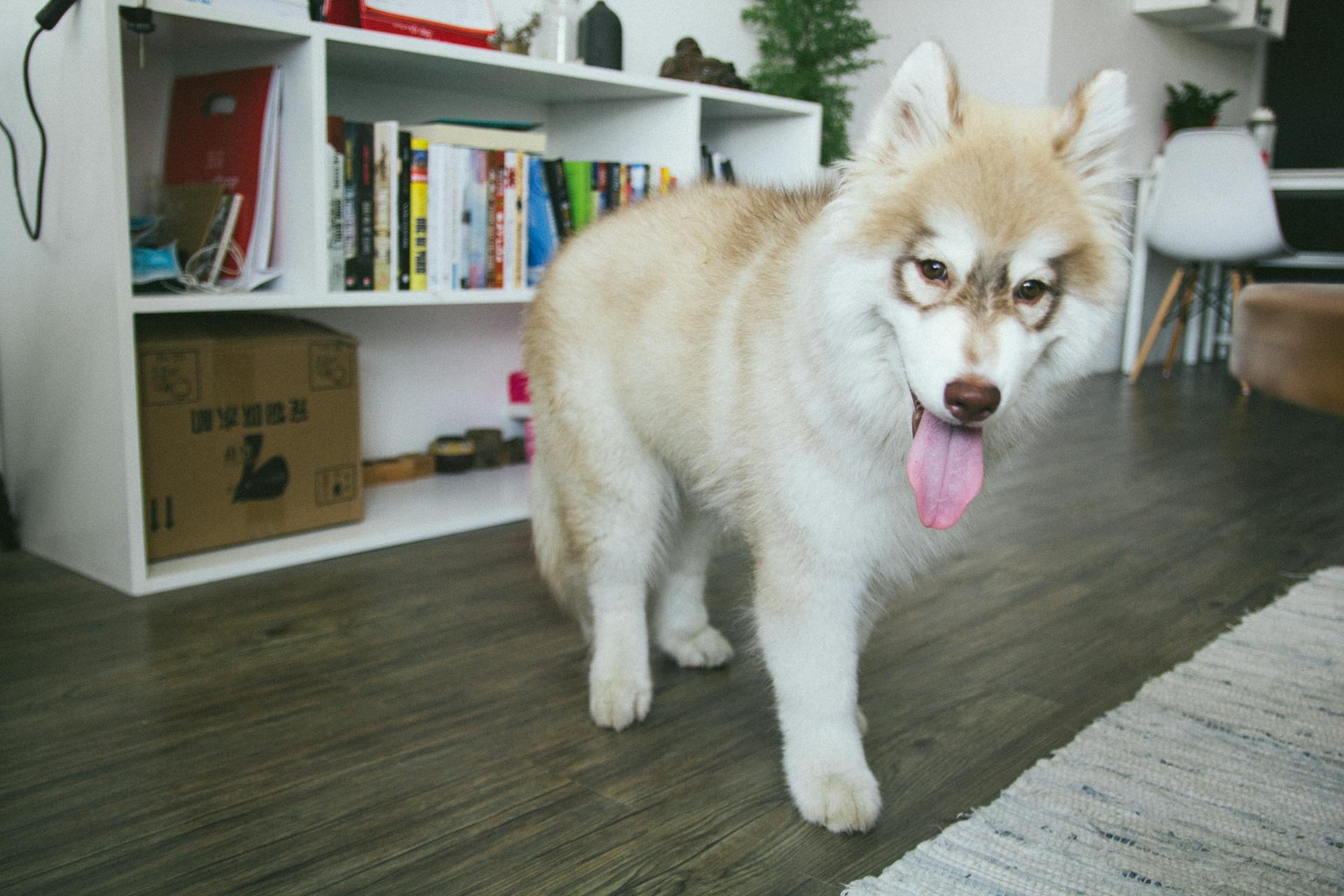
If you're a fan of dogs that howl, you're in luck - there are many breeds out there that love to let out a good howl. Some of these breeds are known for their hauntingly beautiful howls, while others are just enthusiastic about making noise.
The Alaskan Malamute is a prime example of a breed that howls frequently. In fact, they're known to howl at anything from sirens to wolves in the distance. This breed's ancestors were bred to be working dogs, and howling was a way for them to communicate with each other over long distances.
The Alaskan Malamute's howling is often described as a long, mournful howl that can be heard for miles. It's not uncommon for them to howl in response to music, sirens, or even other dogs.
The Siberian Husky is another breed that's known for its howling. In fact, they're one of the most vocal breeds out there, and they love to howl at just about anything.
You might like: Dogs Howl
Why Dogs Howl
Dogs howl for a variety of reasons, and it's not just because they're trying to imitate their wolf ancestors. While wolves howl to communicate with their pack and maintain their territory, dogs howl for similar reasons, but also for some unique ones.
Dogs howl to get attention, communicate with humans and other dogs, express big emotions like separation anxiety, and let others know that they're there. Some breeds are more prone to howling than others, and interestingly, breeds that are more closely related to wolves howl more than breeds that are more recently developed.
Some breeds that are known to howl more than others include bloodhounds and beagles. These breeds are more likely to howl in response to a sound, recognize other dogs, or alert their owners to possible danger.
Here are some common reasons why your dog might be howling:
- They're reacting to a sound.
- Your dog is recognizing other dogs.
- They're trying to alert you to possible danger.
- Your dog doesn't like being alone.
- They're asking you for something.
- Your pup is hurt, or something is bothering them.
Breed Characteristics
Some dog breeds are naturally more inclined to howl than others. Spitz breeds like Huskies and Akitas are known for their tendency to howl.
These breeds are genetically similar to wolves, which may explain their howling behavior. Studies suggest that breeds closely related to wolves are more prone to howling.
Huskies and Akitas are just a few examples of breeds that are more closely related to wolves.
Specific Breeds
Some dog breeds are more prone to howling than others, and it's largely due to their genetic makeup. Breeds like Huskies and Akitas, which are genetically similar to wolves, are more likely to howl than other domesticated dogs.
The Alaskan Malamute is a vocal breed that howls to communicate with their owner and other dogs. They use howling as a primary form of communication, especially when they're in groups.
Here are some breeds that are known for their howling tendencies:
The 25 Breeds
Some dog breeds are more likely to howl than others, and studies suggest that breeds genetically similar to wolves are more prone to howling than those distantly related.
The American Eskimo Dog is a breed known for its stunning white coat and bright, intelligent eyes, as well as its vocal tendencies. They enjoy singing along with their humans or responding to music with howls that are melodious and full of energy.
Siberian Huskies are perhaps the most famous for their vocal nature, known for their wide range of sounds, including howls that can be surprisingly musical. Their howls can express everything from excitement and happiness to loneliness or the desire for attention.
The Alaskan Malamute is a close relative of the Siberian Husky and also possesses a strong inclination for vocalization, including deep, melodious howls. Their howls serve to rally the pack, express their position, or simply join in a communal activity.
The Samoyed is an all-purpose hunting dog suited for bitterly cold weather, and like the previous breed, it worked on sledding teams, and it’s a job some of them still have. They are vocal with an almost shrill quality to their voices.
The Irish Wolfhound has a deep, haunting howl that harks back to their ancestral roots, and their howls are not only a means of communication but also a connection to their wild origins. These gentle giants use their howls to communicate over long distances and express a range of emotions.
Here's a list of some of the breeds mentioned that are known for their howling:
- Siberian Husky
- Alaskan Malamute
- American Eskimo Dog
- Samoyed
- Irish Wolfhound
These breeds, along with several others, demonstrate the incredible range and purpose of dog howls, from practical communication tools to expressions of joy and companionship.
Basset Hound
The Basset Hound is a gentle dog breed that's originally developed to hunt small game like rabbits. They're active, but they can get a bit lazy if they don't get enough exercise.
You'll want to make sure your Basset Hound gets involved in fun family activities and games to keep them active and maintain a healthy weight. With proper care, they can live up to 10-12 years.
Here are some key stats about the Basset Hound breed:
Bluetick Coonhound
The Bluetick Coonhound is a large hunting dog, descended from the French Grand Bleu de Gascogne and the English Foxhound. They have a long, drawn-out howl that they love to bawl out when on the hunt.
Their distinctive voice made them easy to follow in the field, and they're known for their melodious howls, often referred to as "bawling." This sound is crucial during hunting expeditions, as they use their howls to communicate with their pack and human hunters from a distance.
The Bluetick Coonhound's howls are distinctive and can be quite musical, reflecting their enthusiasm for the chase and their strong pack instincts. This breed uses howling to communicate with their pack and hunters, showcasing a blend of work and communication in their vocal behavior.
This breed is also known for their intelligence and endurance, making them suitable for hunting other game as well. Their original job was as a scent hound of raccoons and other medium to large game.
Here are some key facts about the Bluetick Coonhound:
As a family dog, the Bluetick Coonhound loves people and can make a wonderful companion. However, they do have the typical hound dog stubbornness, so persistent and patient training is necessary.
Welsh Springer Spaniel
The Welsh Springer Spaniel is a compact and athletic dog, weighing between 35-55 pounds and standing at 17-19 inches tall.
This breed is developed over 200 years ago as a hunting breed, and they still have that enthusiasm for the hunt. They love to howl after game in the field.
They are equally laid back and gentle in the home, making them wonderful family dogs. Give them plenty of exercise and chances to play, and they'll thrive.
With a life expectancy of 10-15 years, the Welsh Springer Spaniel is a long-term companion. They belong to the Sporting Dog breed group.
Here are some key stats about the Welsh Springer Spaniel:
Collie
The Collie is a breed that originated in Scotland. It belongs to the Herding Group.
They were developed to herd livestock, and as you might expect, they're quite vocal. In fact, they're often referred to as howlers.
Collies are somewhat protective of their family, which makes them good with kids. They view children like livestock they need to keep in check, so they can be a bit bossy at times.
Your Wants
Dogs can be persistent, howling to get what they want whether it's a treat, attention, or their favorite toy.
Giving in to their demands can create a pattern of behavior, making it harder to ignore their howling in the future.
Your dog may howl over and over again to get what they want, similar to a toddler asking for something repeatedly.
Ignoring their howling until they take a break can help them learn to recognize more desirable behavior.
By not acknowledging their howling until they're quiet, you can encourage them to calm down and wait for attention or rewards.
Understanding Howling Behavior
Understanding howling behavior in dogs is crucial to addressing the issue. Some breeds, like bloodhounds and beagles, are more prone to howling than others.
Dogs howl as a way to communicate, stemming from their natural instincts inherited from their wild wolf cousins. This behavior is not unique to any one breed, but rather a universal trait among canines.
Your dog might only howl in response to sounds in their environment, such as car horns or ambulance sirens. Contagious howling is also common in densely populated urban areas where your pup hears vocalizations from other dogs.
Some reasons your dog howls include reacting to a sound, recognizing other dogs, trying to alert you to possible danger, not liking being alone, asking for something, or being hurt or bothered. Understanding the underlying reason for your dog's howling is key to addressing the issue.
Here are some possible reasons why your dog howls, grouped by category:
By understanding why your dog howls, you can take steps to address the underlying issue and restore a more peaceful and quiet home.
What to Do
If you're lucky enough to own one of the breeds that howl, here are some things to consider.
The Alaskan Husky's howling is a natural behavior, and they may howl to communicate with their human family members.
To encourage positive howling, provide your dog with plenty of attention and interaction, as the Alaskan Husky thrives on human interaction.
You can also try singing or making other sounds to stimulate their vocal cords, as the Alaskan Husky is prone to responding to musical sounds.
Remember, howling is a normal behavior for these breeds, and with patience and understanding, you can learn to appreciate and even encourage it.
Is It a Problem?

If your dog's howling is occasional and has an obvious reason, like responding to a police siren, there's no need to worry. But if it's excessive and focused on things that aren't a danger, like the mail delivery or a friend stopping by for coffee, it can become an issue.
Excessive howling can be a sign of boredom, so make sure to spend quality time with your pup, take them for walks, and provide adequate physical and mental stimulation.
Ignoring their howls for attention and rewarding them for being quiet can help.
What to Do If Your Dog Howls
If your dog howls excessively, it can be a real challenge. Don't worry, there are some effective strategies to help you address this behavior.
Ignoring attention-seeking behavior is key. Avoid giving your pup a reward when they howl by ignoring them when they start. Don't look in their direction, speak to or touch them, as this can make their behavior worse.
Ignoring your dog's howling doesn't mean you're not paying attention to them. It's just about not reinforcing the behavior. By ignoring the howling, you're teaching your dog that it's not a way to get attention.
Ignoring attention-seeking behavior can be tough, especially if your dog is used to getting a reaction from you. But it's a crucial step in stopping the howling behavior.
Frequently Asked Questions
Is it rare for dogs to howl?
No, howling is not rare in dogs, as it remains a common form of communication. According to the American Kennel Club, dogs howl for normal reasons such as seeking attention or alerting their owner to potential danger.
Sources
Featured Images: pexels.com


